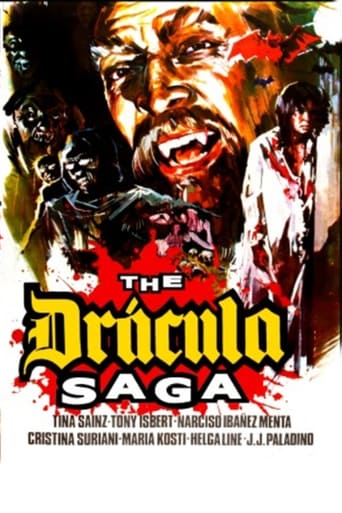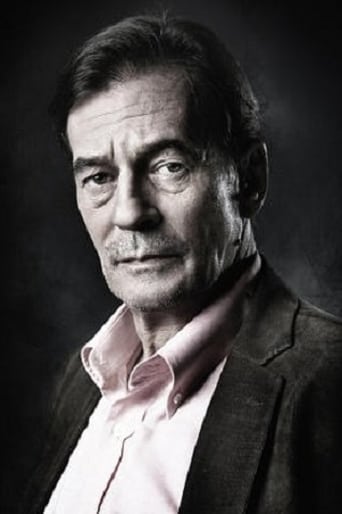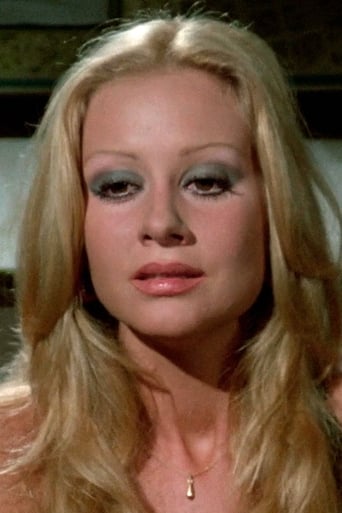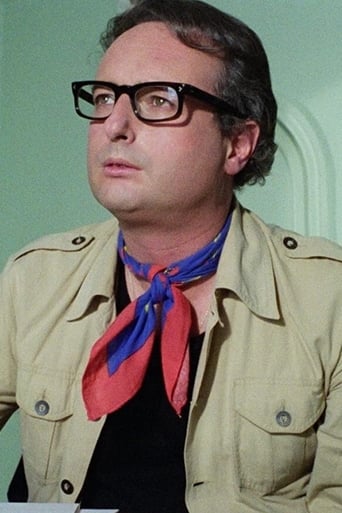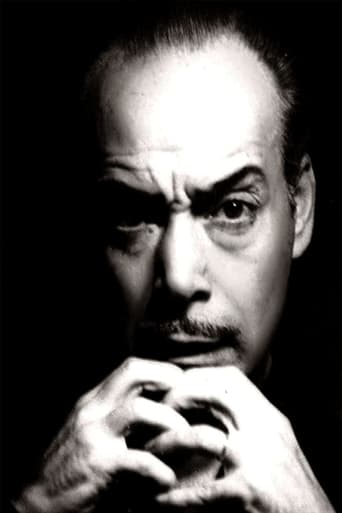Smartorhypo
Highly Overrated But Still Good
Supelice
Dreadfully Boring
AutCuddly
Great movie! If you want to be entertained and have a few good laughs, see this movie. The music is also very good,
WillSushyMedia
This movie was so-so. It had it's moments, but wasn't the greatest.
jacobjohntaylor1
There are a lot of Dracula movies made around this time that were great . And this is not one them. This Dracula sequel unlike most Dracula sequels is not scary. It is badly written. Badly acted. It has an awful ending. Don't wast your money. Don't wast your time. Don't see this movie. It is about Dracula trying find his descendants who don't know he his a vampire. He trying to turn them into vampires. This could have been a good movie. If it was not so badly acted. So badly written and had such an awful ending. Pooh pooh, pooh pooh, pooh pooh, pooh pooh, and pee pee to. Don't see this movie. Don't see it. Don't see it Don't see it.
Witchfinder General 666
Director Léon Klimovsky is probably best known for his collaborations with the Spanish Horror/Exploitation/Cult icon Paul Naschy, most notably for what is maybe also Naschy's most famous film, "La Noche De Walpurgis" (aka. "The Werewolf vs. the Vampire Woman", 1971), which is the most widely known of fourteen films in which Naschy played the Werewolf Waldemar Daninsky. Klimovsky made quite a bunch of slightly bizarre Gothic Horror films, which are not all the same quality. Even though Naschy is not involved in this film, "La Saga De Los Drácula" aka. "The Saga of the Draculas" aka. "The Dracula Saga" of 1973 is certainly one of Klimovsky's better films. "La Saga De Los Drácula" is a very different approach to the common Dracula topic which is interesting, to say the least. This time, it is not merely the famous Count, but an entire family of noble blood-suckers that cause fear in the Transylvanian mountains.The pregnant young Berta (Tina Sáinz) and her husband are moving to Transsylvania to be with Tina's family, the patriarch of which is her grandfather - Count Dracula (Narciso Ibáñez Menta). The elderly Count lives with his three gorgeous brides (Helga Liné, Betsabé Ruiz and Maria Kosty) as well as some other relatives. Needless to say that the Dracula family's favorite beverage isn't raspberry juice, which the innocent Berta and her husband are entirely unaware of..."La Saga De Los Drácula" is an overall very interesting and highly atmospheric film that bears more surprises and unexpected elements than one might think. Spanish Gothic Horror films such as Klimovsky's usually have a very particular inimitable charm to them, and "La Saga De Los Drácula" a good example for that. Even though the budget obviously wasn't gigantic, the atmosphere is eerily beautiful, and the plot is quite original. The female cast members are entirely gorgeous, especially the red-headed Helga Liné, who is known for her (often sexy) roles in other European Gothic Horror productions including "Nightmare Castle", "Horror Rises From the Tomb", "Las Garras De Lorelei", "Mio Caro Assassino" and others. As it is to be expected, the film includes its share of nudity, sleaze and gore. Narciso Ibáñez Menta is a very unusual (since very old, and comparably un-villainous) Count Dracula, which isn't a bad thing; on the contrary, this different version of the most famous of Vampires contributes to the film's originality. The cinematography is elegant as in all Klimovsky films, and the music by Johann Sebastian Bach fits the film amazingly well, especially the harpsichord parts.Overall, "La Saga De Los Drácula" is a highly original Vamprie film that does more than to simply deliver what is expected, and highly recommendable to my fellow Eurohorror buffs.
MARIO GAUCI
This is another film I had never heard of until recently; being a devotee' of both the vampire subgenre and the "Euro-Cult" style I was instantly intrigued, especially since the copy I came across promised to be of a reasonably high quality, having been released on DVD through BCI – unfortunately, though, I had to make do with the substandard English-dubbing since the original Spanish version carried no accompanying subtitles! I was nonetheless rather disappointed by the end result, even if I should have been forewarned of this via the other titles I had watched from the director involved!; the fact that only one member of the cast (the ever-luscious Helga Line') was familiar to me did not help matters.Incidentally, the general goofiness on display reminded me I had a number of vintage Mexi-Horror efforts still to catch up with; indeed, the film starts off with a truly weird scene in which the heroine (a descendant of the Draculas) dreams she is being literally menaced by a bat-man! There are several more scenes in this vein: one where it seems that all the inhabitants of a village are impaired in some way (hunchbacked, lame, half-blind, etc.), not to mention the presence of Dracula Jr. as a horrific Cyclops with webbed fingers! Bafflingly, while the seemingly obtuse villagers keep commending the Dracula family to the new arrival, they are surprised by this outburst of vampire attacks...duh! For this reason, the entire family looks upon the heroine as the last hope of the vampire bloodline (even if she is not one herself), since the girl is pregnant by her lanky blond husband; when the couple finally arrive at Castle Dracula, she asks the keeper to show her the tomb of her grandmother…where the coffins of the current members of the family are also plainly in sight, which she obviously finds not a little odd! Despite the expected emphasis on nudity (this was probably yet another example of an "International Version") and ghoulishness (with the color scheme intentionally on the dreary side), the film is both plodding (feeling much longer than it actually is) and slapdash (though intermittent 'filmed-through-a-gauze' shots seem at the very least to be intentional, albeit superfluous, or else inherent in the negative!).Ultimately, one regrets the film not being somewhat better than it is, as the script appeared to be striving for something more than the usual blood-sucking fare: the whole ROSEMARY'S BABY (1968)-like subplot, the melancholic/philosophical tone adopted by the atypically elderly Count (though he reverts to camp at the very end when his disembodied head breaks up into laughter!), not to mention a climax in which the leading lady goes berserk and becomes the axe-wielding executioner of her own brood (even if she is herself mortally wounded in the massacre)…though it all contrives to keep the Dracula name alive (after all) by feeding the infant with the dripping blood of its own mother!
Scarecrow-88
Count Dracula(Narciso Ibáñez Menta), his nieces, Irina and Xenia(Cristina Suriani & María Kosty) and new wife, Munia(Helga Liné) are excited at the thought of a new heir, to be born by his granddaughter who has been living in London away from Castle Vlad in Transylvania for some time. Berta(Tina Sáinz) and her husband Hans(Tony Isbert) are to visit and possibly live in Castle Vlad as heirs to Vlad Tepis' estate and castle. What Berta doesn't realize is that her unborn son is drinking her blood from the womb, exhausting her, while Hans has become a victim at the seductive hands of Munia. Meanwhile, the vampires strike locals as Dracula prepares for the grand day of his grandson's arrival, with Berta suffering not only physically, but her steady fear has evolved into mental deterioration, with isolation and the loss of Hans having quite an effect. Director León Klimovsky maintains a really strange ambiance as the film builds towards the birth of a new beginning for Dracula's family. Dracula, as portrayed here, is an old, sad, pitiful sight, while the vampire women have vitality, quite precocious and promiscuous. Helga Liné captivates as always, just when appearing on screen, her power is just magnetic. The pale make-up for the vampire family is ghastly and their existence is equally dreary and decadent. The film is at times wicked, playful, weird, and violent. You have an one-eyed mutant offspring often whipped by Dracula for killing people and is such an embarrassment to him that he's locked away. A bible-quoting priest, who is ridiculed for looking at pretty girls, falls prey to Berta's devious cousins. Liné doesn't wait very long before seducing Hans and he's a willing victim. María Kosty, as Berta's cousin, Xenia, might be recognizable to Spanish horror fans for she has starred in such fare as Jess Franco's Exorcismo, Ossorio's Night of the Seagulls, A Dragonfly for Each Corpse and Vengeance of the Zombies. Tina Sáinz, as Berta, pretty much remains either frightened, paranoid, or off-the-deep-end, and it's understandable since this movie places her in a bleak situation. While there are moments of graphic violence, such as some ax-chopping and a poor fellow's flight down a spiral staircase, this movie wasn't as gory as I was expecting. There's some blood-sucking(..the necking, however, mostly occurs off-screen, bloody throat wounds shown afterward). Castle Vlad is, surprising enough, rather sunny and vibrant, not gloomy or melancholy as those who live within it's environs..quite a difference from the typical Gothic horror flicks which contain a castle, crypt, and nearby cemetery. A great deal of the film is shot during the day, or as the sun rises, another difference from what we are accustomed to. We see the vampires actually out and about as the sun remains in the sky, even though we can tell it annoys/bothers them, until they eventually must return to their resting place. Ends on a darkly comic note with Dracula, all fangs, grinning fiendishly.
